
Timo Snieder from Canada contacted me long time ago and told me that his girfriend Ramata and him wanted to do a grand Tanzania trip that included Climbing Kilimanjaro, Safari on the northern sircuit (Tarangire, Serengeti and Ngorongoro + getting as many birds as he could. He had already booked the climb. I got my business partner Kevin Mlay to his Safari so on the evening on July 18, they were driven to my door by the safari driver. It was Timo and Ramata, Nicole (a birder) and her boyfriend Chris and Timo´s father Gord. They had done Tarangire, so we were to do Lark Plains, Same, South Pare, East and West Usambara, before the entire gang ex father flew off to Pemba. Only Timo would later join me in Dar es Salaam to do the Southern Highlands.
Day 1 Sunday July 19. Lark Plains
We set off early from my home this time in two cars to fit everyone. Our first bird was a couple of Secretarybirds. We soon found the target Beesley´s Lark, had too search a little for the Short-tailed Lark, but dipped on the Athi Short-toed Lark. We only spent a short time on the plain and started driving slowly towards Saruni´s (The Masai guide) Booma. We picked up Rosy-patched Bushshrike, Taita Fiscal, Chestnut-bellied Sandgrouse and Foxy Lark on the way. We parked at the booma and started to pick up good birds: Red-fronted Warbler, Grey-capped Social Weaver, Northern Red-billed Hornbill, Hildebrandt´s Starling, Reichenow´s Seed-eater, Abyssinian Scimitarbill, Banded Parisoma, White-bellied Canary, White-headed Mousebird, White-bellied Go-away Bird, Grey Wren-Warbler and a lot more. It might have been a little too much for the non birders, but the birders really enjoyed it. We went back to my house and I dropped Timo´s father off at the airport. Came back to the house and the ladies made a nice meal for us. We settled to bed nice and early.
Some pictures from Day
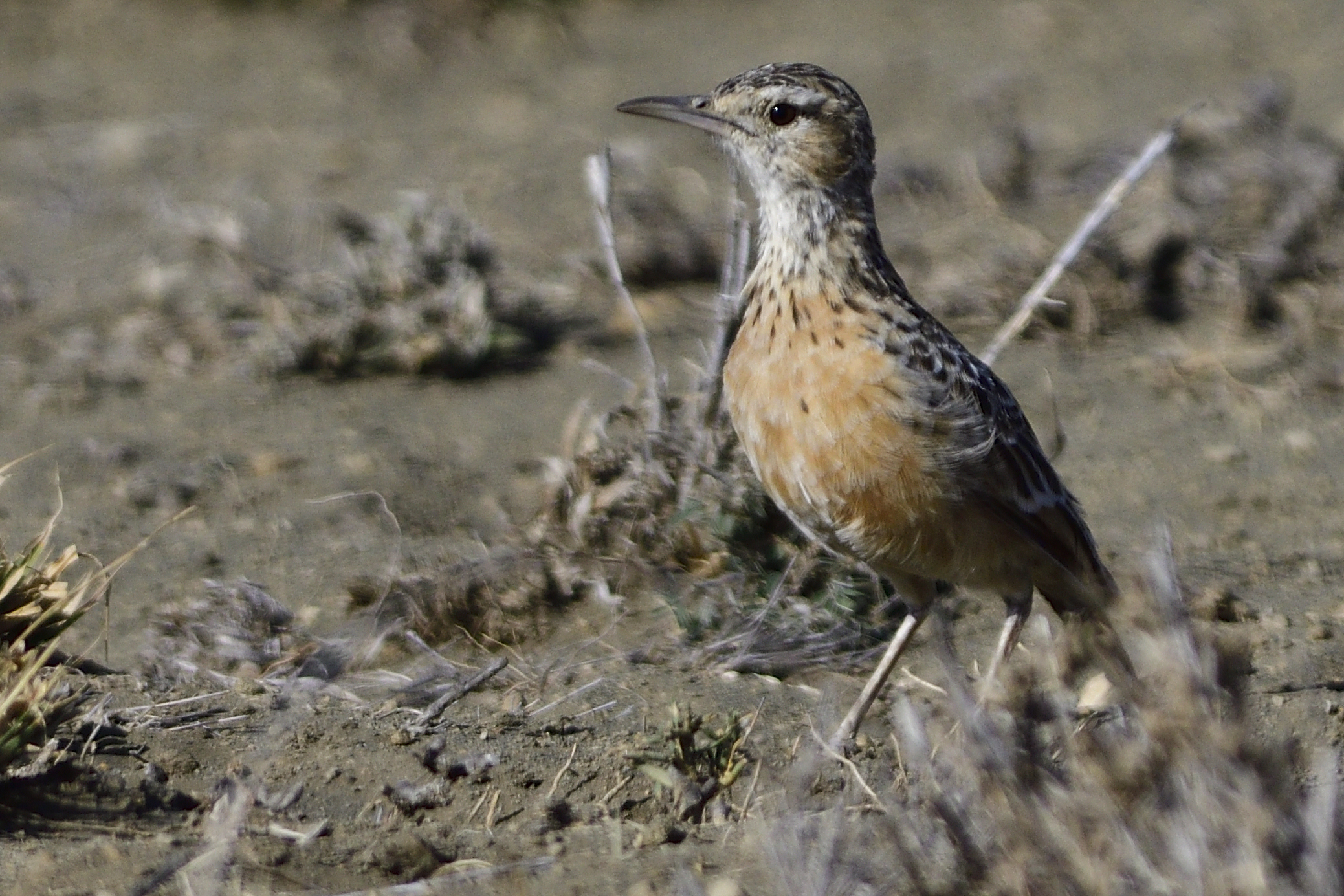
Beesley´s Lark, Chersomanes beesleyi – Endemic to Engikaret, Tanzania

Rosy-patched Bushshrike, Rhodophoneus cruentus – Endemic to NE Africa

Taita Fiscal, Lanius dorsalis – Endemic to NE Africa
Day 2, Monday July 20 – Kiligolf to Same
We set off quite early and an uneventful ride took us to the turn off at Nyumba ya Mungu Dam where we met our guide Martin Joho. We drove to our normal spot and started birding. Southern Grosbeak Canary, Eastern Violet-backed Sunbird, Red-fronted Warbler, Red-billed Oxpecker, Grey Wren-Warbler, Sombre Greenbul, Hunter´s Sunbird, Pink-breasted Lark, Somali Bunting, Parrot-billed Sparrow, Purple Grenadier, Vitelline Masked Weaver, Van der Decken´s Hornbill fantastic views of Scaly Chatterer, Green-winged Pyttilia, Pygmy Batis, White-bellied Canary, Yellow-spotted Petronia, Bare-eyed Thrush Slate-coloured Boubou and White-headed Mousebird were collected within a few hours walk. We continued down to the Dam itself to add some more birds to the list. The only interesting ones were Blue-naped Mousebird, Spur-winged Lapwing, Rufous Chatterer and Northern Brownbul. Other than that just regular waterbirds. On the road again driving closer to Same to a place just outside Mkomazi NP that is a regular spot for Martin and me, we found the following interesting birds: D´Arnaud´s Barbet, Straw-tailed Whydah, Fischer´s Starling, Long-tailed Paradise Whydah, African Hoopoe, Grey-headed Bushshrike, Pygmy Batis, White-crested Helmetshrike, Mouse-coulored Penduline-Tit, Tiny Cisticola, Red-faced Crombec Nubian Woodpecker, Eastern Black-headed Batis, Red-fronted Tinkerbird, Black-throated Barbet, Black-chested Snake Eagle, Brown Snake Eagle and Black Bellied Sunbird. We were quite far up the hillside when Martin suddenly whispered Elephant. We slowly retracted and sure enough a huge female Elephant emerged from the bush. We walked slowly back to the car and made sure we kept a safe distance between us and the Ellie. When we reached the road some locals had gathered and they set off to chase the Ellie away before it reached their crops. The huge mammal turned and walked quietly away. The day was almost over and we drove to the normal spot for the night, Elephant Motel in Same. We freshened up had a dinner and a few beers and settled in for the night.
Some pictures from Day 2

Southern Grosbeak Canary, Chrithagra buchanani – Endemic to S Kenya and N Tanzania

Eastern Violet-backed Sunbird, Anthreptes orientalis – Endemic to NE Africa
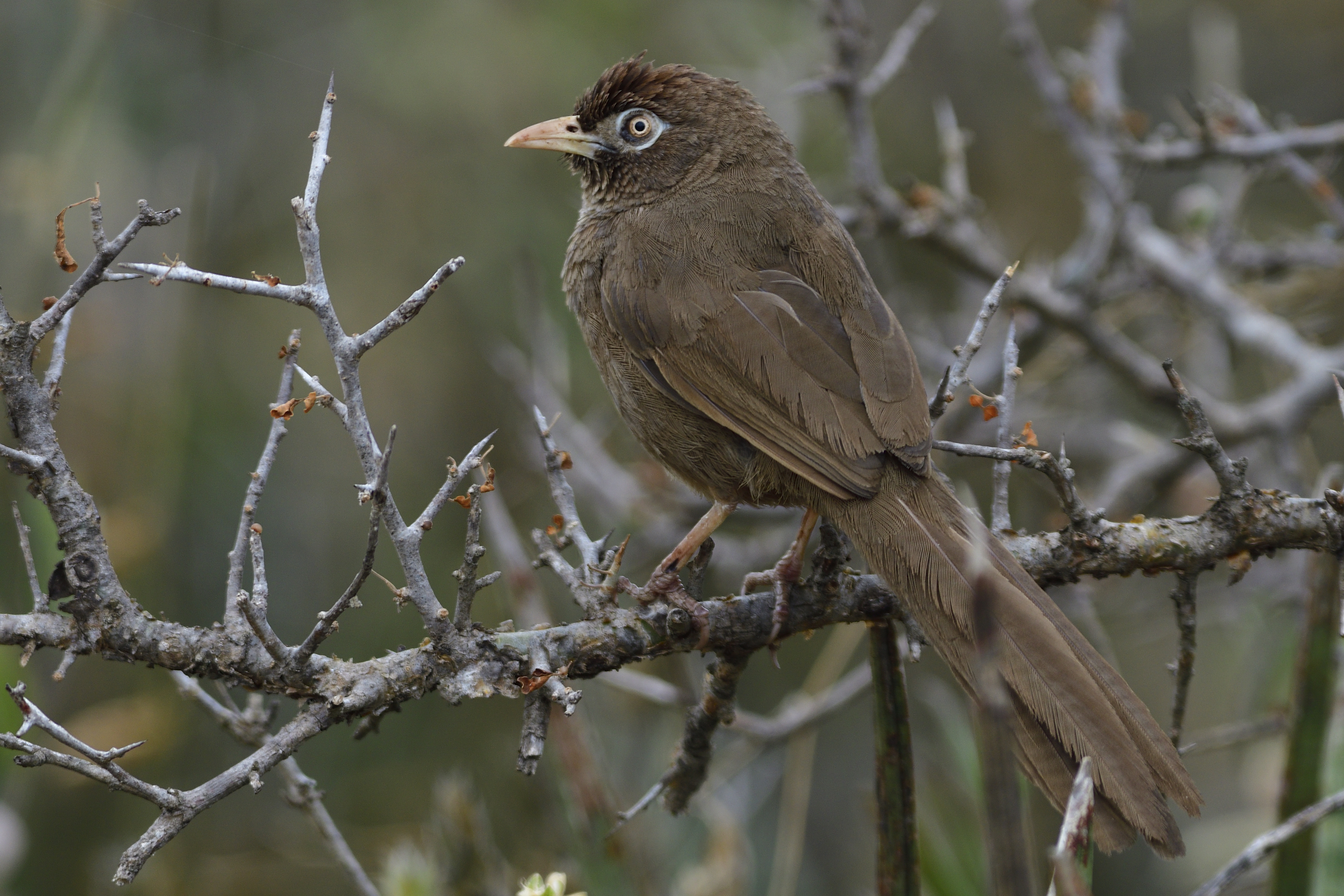
Scaly Chatterer, Turdoides aylmeri – Endemic to NE Africa
Day 3, Tuesday July 21 – Same to Magamba Forest, West Usambara via South Pare Mountains
We started early from the motel and the take off to South Pare is just outside Same. It is a dreadful 1 hour drive on very bad roads before you come to the little forest patch that holds the sought after endemic South Pare White-eye. We parked at the normal spot and was as ever greeted with the call of the Evergreen Forest Warbler. A bird I have seen a few times, but hear all the time and I have actually given up getting a picture of this bird. We walked the normal road and had some nice birds including: African Hill Babbler, Placid Greenbul, Black-headed Apalis, Yellow-throated Woodland Warbler, Black-fronted Bushshrike, Stripe-faced Greenbul, Moustached Tinkerbird, Usambara Double-collared Sunbird, East Coast Boubou, Singing Cisticola and Dark-capped Yellow Warbler, before we sighted the South Pare White-eye. This was our only real target here. However; we still had some time and continued birding: Eastern Bronze-naped Pigeon, Oriole Finch, and Harlaub´s Turaco. A nice morning session in the South Pare Mountains. We got back in the car and headed for Magamba Forest in the West Usambara. We have a camp there at an old Sawmill. First we had to drive down to the main road, then about 100 km to Mombo, before the exiting road starts that takes you to Lushoto. The road are rumoured to have been build by the germans before World War 1. We stopped at Soni to buy vegetables etc. passed Lushoto and arrived in time for the afternoon birding . We quickly set up camp and was into the birds: Red-capped Forest Warbler, Waller´s Starling, Usambara Double-collared Sunbird, White-tailed Crested Flycatcher, Moustached Tinkerbird, Orange Ground Thrush, Spot-throat, Olive Woodpecker, Black-headed Mountain Greenbul, Hartlaub´s Turaco and Cinnamon Bracken Warbler was the birds we managed to see before we resided to camp.
A picture from Day 3

Sout Pare White-Eye, Zosterops winifredae – Endemic to South Pare Mountains, Tanzania
Day 4, Wednesday July 22 – Full day Magamba Forest
We walked off early in the morning added Mountain Buzzard, White-chested Alethe Grey Cuckooshrike, Shelley´s Greenbul, Yellow-streaked Greenbul, Green Barbet, Crowned Eagle, Sharpe´s Starling, Stripe-faced Greenbul, Fülleborn´s Boubou, African Hill Babbler, Usambara Akalat and Forest Batis before breakfast. We had a long relaxed afternoon in camp. Martin, Nicole and Timo went a head of me. After 5 minutes, Martin came running to fetch me, he shouted Usambara Weaver, Usambara Weaver on a previous pass up that track I had told Timo where I had the only sighting ever of the Usambara Weaver. On the way up, he had played the tape once and both a male and a female flew right in. Lucky for me, they were still there when I arrived with my camera ready. What a fantastic sighting. Thank you Martin and Timo. We continued up the pass, but nothing new. We retired to camp and had a lovely meal.
Some pictures from day 4

Cape Robin-Chat, Cossypha caffra
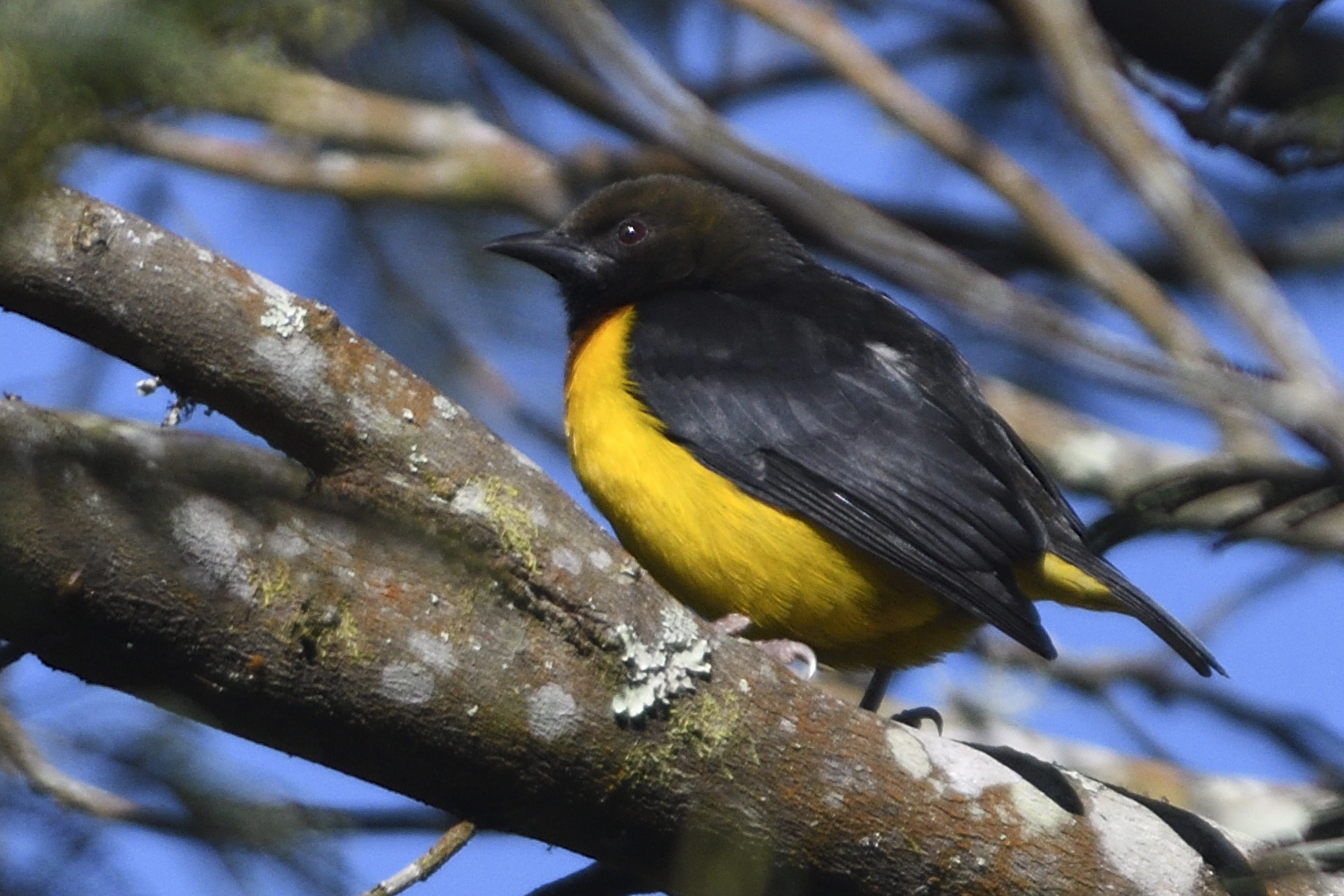
Usambara Weaver, Ploceus nicolli – Endemic to Eastern Arc Mountains of Tanzania

Three happy campers in Magamba Forest. Nicole, Per and Timo
Day 5, Thursday July 23 – Magamba Forest
We only had two of the Magamba specials yet to find, The Thrush and the Greenbul. We had plenty of time, but despite searching the entire day, we did not manage to come up with any new birds. Timo and Martin even resorted to serious bush bashing without anything new. Life in Magamba is wonderful and it is my favorite birding spot in Tanzania

Cold and not the best weather, but everyone seems to enjoy?
Day 6, Friday, July 24 – Magamba Forest to Amani Forest East Usambara
Our last opportunity to find the 2 missing targets and yes, we got the Usambara Thrush. We dipped on the Greenbul though. We packed camp and drove to the lover part of the forest. No, new birds but Timo got obsessed with the Chameleons. We stopped at the office and since I am such a good customer at Magamba, the Manager Getruda wanted a group picture in front of the Landy. We were soon on our way to Amani Forest. We stopped in Muheza for some vital vegetables and started the dreadful way up to The Amani Headquarter, where we were going to stay for 3 nights as well. We arrived quite late, so no real time for any birding. The other decided to camp, but I took a room at the headquarter. During the middle of the night Timo had been woken up by some strange calls, he went to investigate and he found a pair of Usambara Eagle-Owls. Unfortunately his camera was in the Landy. He woke me up and we went to look for them Camera in hand, but they were no where to be seen.
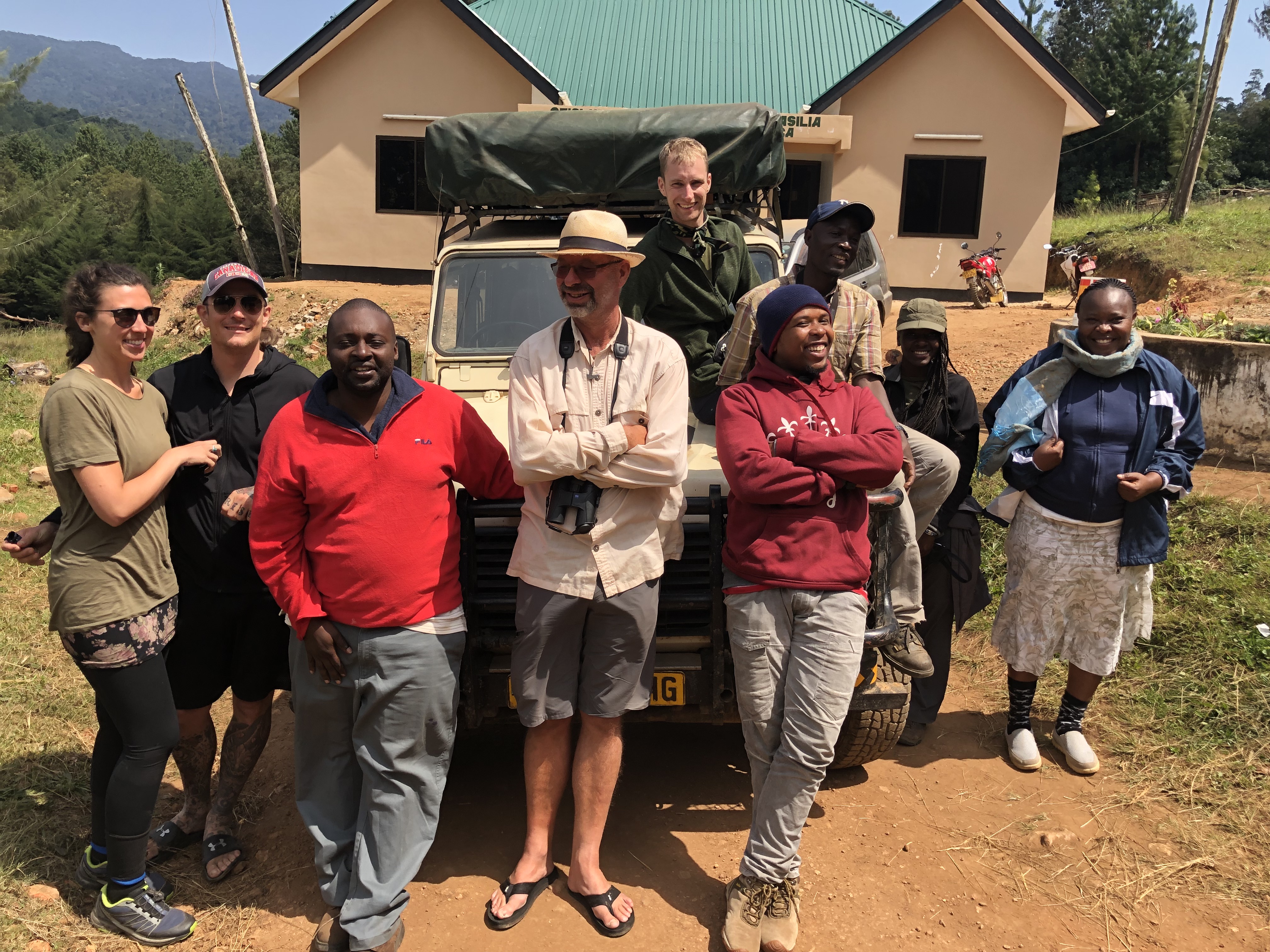
At the gate off Magamba, Getruda to the far right
Day 7, Saturday July 25 – Amani Forest
The two main targets for the day was the Long-billed Forest Warbler and the Kretchmer´s Longbill. We loaded into the car and set off for the spot were we normally find these birds. The first bird we got in good view was a striking Fischer´s Turaco. We got both Pale and Forest Batis and an Uluguru Violet-backed Sunbird in a habitat I had never seen it before. Green-headed Oriole also showed good before we came to the spot for the Long-billed Forest Warbler. The bird did not disappoint. A surprise for me was a Scaly-throated Honeyguide. We were struggling to get the Kretchmer´s Longbill, but eventually we got views of one. Even bigger surprise for me that I finally managed to see a Pale-breasted Illadopsis. This bird has been one of my bogey birds. We always hear it, but to see it is not the same. I finally have seen it! Next challenge for me will be to get a picture. Before we left the site, we also had good views of East Coat Boubou. We went to a new sight were Martin had never taken me? The place was good for Sharpe´s Akalat Martin told me? And yes, he found us a Sharpe´s Akalat, my second lifer for the day! It is very far between when I get lifers in Magamba or Amani Forests, the best I usually hope for is better pictures of birds I already have. Martin took us into a forest path were we had fantastic views of two Usambara Thrush. We returned to camp for lunch and some rest, but was soon ready for the afternoon walk. We started the walk around the botanical garden and connected with Waller´s Starling, African Golden Oriole, Southern Citril, African Green Pigeon, Banded Green Sunbird, Moustached Tinkerbird, Red-rumped Swallow, African Harrier-Hawk, Black-and-white Shrike Flycatcher and Palm-nut Vulture. We returned to camp and had a fly by of a Bat Hawk before a couple of Olive Ibis flew over twice. My third lifer for the day! What a fantastic day!
Some pictures from Day 7.

Scaly-throated Honeyguide, Indicator variegatus
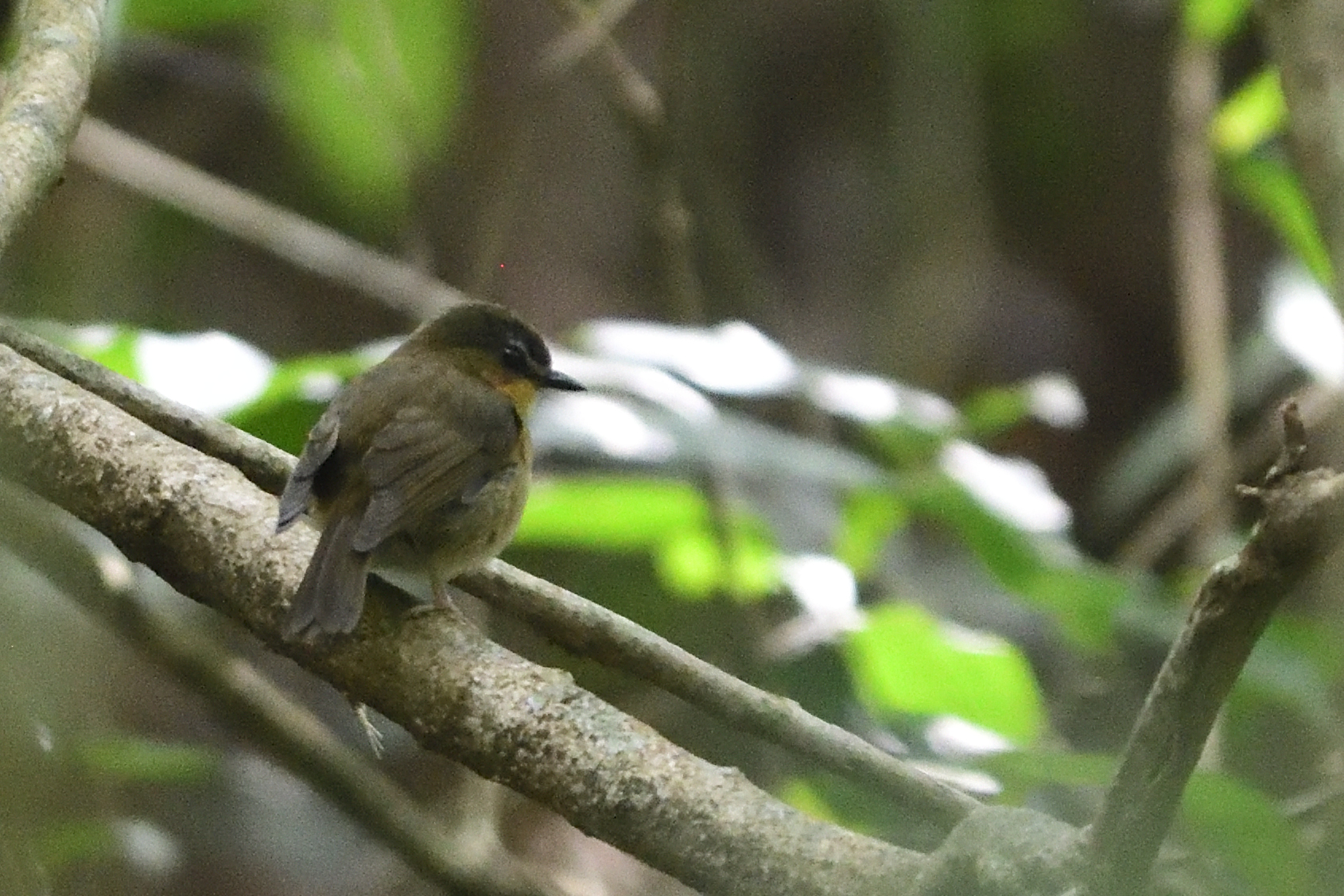
Sharpe´s Akalat, Sheppardia sharpei – Endemic to Eastern Arc Mountains

Banded Green Sunbird (Female), Anthreptes rubritorques – Endemic to Eastern Arc Mountains, Tanzania
Day 8, Sunday, July 26 – Amani Forest
We decided to go up and get better views of some of the birds from the day before. When we crossed the stream for the first time, we had great view of a Giant Kingfisher. On the next bridge, we heard a Half-collared Kingfisher calling and after a little searching we found it perched by the river. I know this bird hangs around in the area, but this was my first sighting of it there, actually my first sighting of this bird in East Africa. We did not find much more of interest uphill, so we returned to camp for breakfast. In the afternoon, we did the lower loop again and added a few birds to our Amani list: Long-crested Eagle, Black Cuckooshrike, GreenBarbet, Green-backed Honeybird and Red-tailed Ant-Thrush besides all the ones we had seen before.
Some pictures from Day 8

Half-collared Kingfisher, Alcedo semitorquata
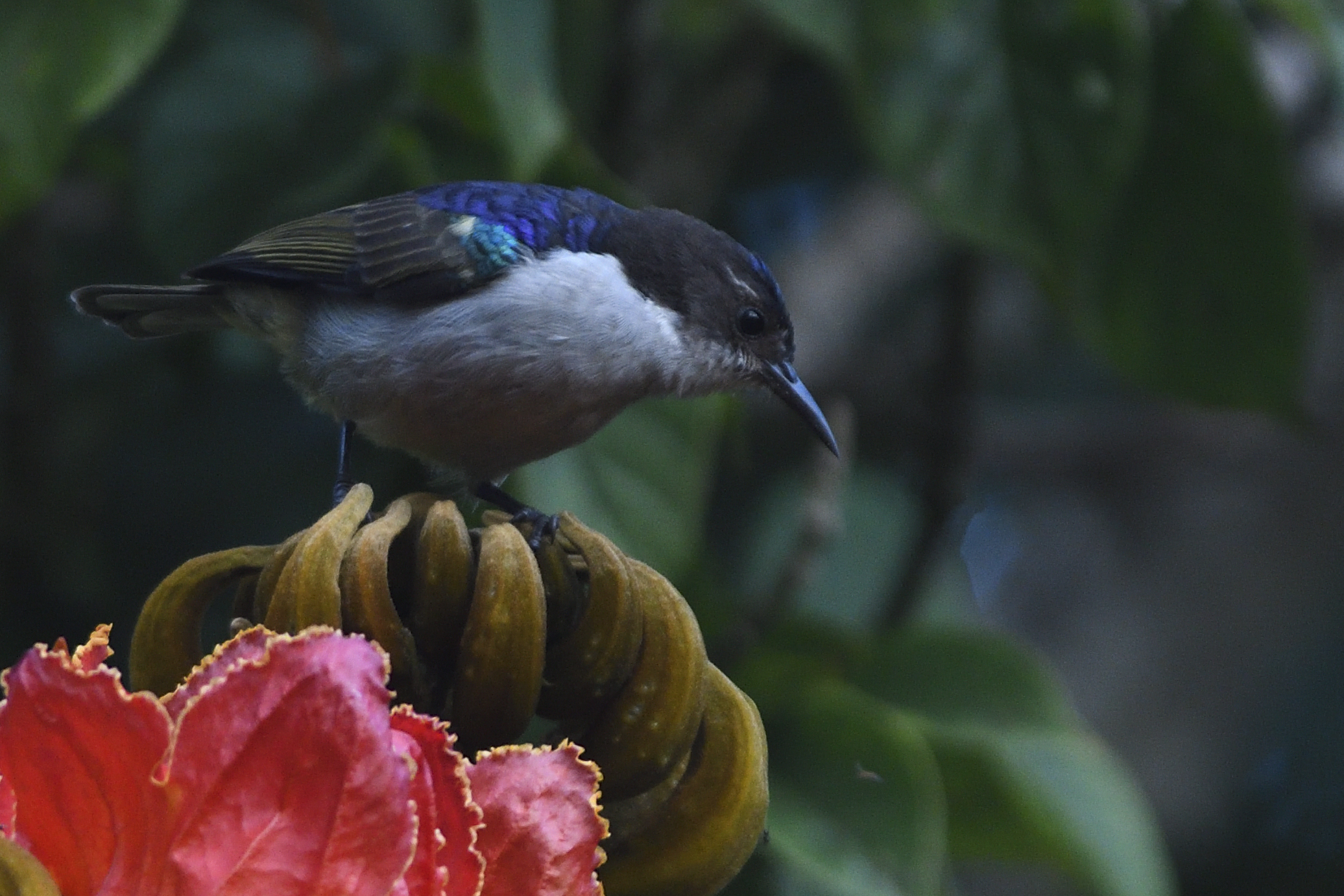
Uluguru Violet-backed Sunbird, Anthreptes neglectus – Localised endemic to East Africa

Red-tailed Ant-Thrus, Neocossyphus rufus
Day 9, Monday, July 27 – Amani Forest to Tanga Airport
This was the last day with the group. Today we were going to bird the lower parts of Amani which have quite different birds to the upper region. We packed the car and headed down hill. We parked at the regular spot and started birding. The new birds came in: Dark-backed Weaver, Little Yellow Flycatcher, Square-tailed Drongo, Little Greenbul, Green-headed Oriole, Pale Batis, Grey Cuckoshrike, Green Barbet, Black Sparrowhawk, Klaas´s Cuckoo, Black-headed Apalis, Red-capped Robin-Chat, Plain-backed Sunbird, Narina Trogon, Green Tinkerbird, Yellow-rumped Tinkerbird, Fischer´s Greenbul, African Harrier-Hawk, Green-backed Honeybird, Black-fronted Bushshrike, Lowlnad Tiny Greenbul, Mombasa Woodpecker, Usambara Hyliota, Red-throated Twinspot, Blue-mantled crested Flycatcher. Fantastic birding in this little patch of forest. Every one was happy and we sat out for Tanga airport. All 4 were going to spend 3 days there hunting for the Pemba endemics. I had set them up with a local guide + they were also going to enjoy some snorkeling and diving. I was to meet Timo in Dar es Salaam on August 1 to continue our trip towards some challenging birding in the southern highlands. After dropping them, I drove to Dar es Salaam alone for some relaxed time.
One picture lifer from day 9

Usambara Hyliotha, Hyliota Usambarae – Endemic to Usambara Mountains, Tanzania
Day 10, Thursday August 1, Dar es Salaam via Morogoro to Uluguru Mountains
I changed to an airport hotel the day before and picked up Timo. Unfortunately his luggage was unloaded at Zanzibar the day before, so we had to go back to the airport to wait for it. It did arrive and we were soon on our way. We picked up Martin at Chalinze and continued towards Morogoro. In Morogoro, we picked up Elia and started the climb up the mountains towards our campsite. The road was so bad that we had to stop at a small village to weld part of my exhaust system that had fallen off. We soon arrived in camp which was now on a football pitch and made camp and cooked dinner. We attracted a huge crowd of locals that wondered what 2 Wazungus (White men) were doing up there.

Local crowd

Chef Holmen is dishing up – on camping trips in TZ it is very hard to get meat, so we turn vegetarians for a few days.
Day 11, Friday, August 2, Hike to Camp + birding in the Uluguru
We had an early start on the walk. It is quite a depressing walk because you walk through shamba (cultivated fields) for a long time before you finally reach the forest. Once at the forest edge it is a very steep walk, but this time I made it without a struggle. The porters were already there setting up camp. Loveridge´s Sunbird, Eastern Bronze-naped Pigeon, Waller´s Starling, Livingstone Turaco, Green-headed Oriole, Chapin´s Apalis, Green Barbet, White-tailed Crested Flycatcher, Red-capped Forest Warbler, Moustached Tinkerbird, Grey Cuckooshrike, Stripe-faced Greenbul, Banded Green Sunbird, Bar-tailed Trogon, Yellow-streaked Greenbul and Fülleborn´s Boubou were the special birds we saw. We cooked had a beer and settled in for the night. Later in the tent that night I got some very disturbing news from Norway that really hit me hard.
Some pictures from Day 11

Bar-tailed Trogon, Apaloderma vittatum

Camp in Uluguru Mountains
Day 12, Saturday, August 3, Birding Uluguru then drive to Simbamwenni camp Morogoro
I was not in any form shape or mood to any birding that day, but the boys took off and return to camp a few hours later and they had found the Uluguru Bushshrike apparently after some heavy bush bashing. We packed up and hiked down to the car, packed up and drove to Simbawenni camp where we were greeted by Annie. Tim volunteered as cook for the night and made us a lovely meal before we turned in.

With Annie & Mike at Simbawenni
Day 13, Sunday, August 4, Morogoro to Uluguru mountain.
Elia had another place in Uluguru mountain for the two other special Uluguru birds, the Greenbul and Mrs. Moreau´s Warbler. It was a gruelling drive some time the roads were so narrow and there were vegetables for sale on both sides of the road, I ended up smashing vegetables to get through. Finally we came to a beautiful river, we crossed the river and were presented with a fantastic campsite. The care taker turned out to be a very nice guy that took extremely good care of us. I took the opportunity to go for a swim in the river. It was crystal clear and held a decent temperature. The boys went for an afternoon bird walk, while I was just lingering around camp licking my wounds. The boys came back and we made dinner and enjoyed the bonfire before we retired early to bed.
Day 14, Monday, August 5 – Uluguru Mountains
I was still in no mood, shape and form to do any birding, but the boys took off. Timo came back smiling all over his face quite a few hours later having bagged both target birds + very good views of the Grey-winged Robin-Chat. The care taker managed to get hold of a local chicken that he presented for us live. It had to be killed and plucked and he produced a very nice meal for us.

Mr Joho posing with our meal 🙂
Day 15, Tuesday, August 6 Udzungwa to Ukaguru mountains.
I finally shook my problems off and was ready for birding again. We had a long drive to the small town called Geiro. We went to the ranger post and obtained our license. Unfortunately someone from the local immigration got wind of 2 Wasungu (white people) in the area. We were called to the immigration office to show our visas and passports. The lady wanted a copy of our passport that we had to produce our self in order to let us out of her office. Not the first time I have been harassed like that in Tanzania. With the lady satisfied with a copy of both our passports, we finally took off for the next leg up the mountain. It was fantastic scenery, but the road was not very good. After a long drive, we finally reached the forest very late due to our delay by immigration. Elia had a tiny camp site inside the forest where I had to bulldoze my way with the Landy to get in to. We set up camp and were soon out birding. Livingstone Turaco, Moustached Tinkerbird, Evergreen Forest Warbler before we finally located one of our targets: Rubeho Warbler. We stayed with a pair of them for our an hour and had glimpses deep inside. At one point, the bird jumped out in the open, but unfortunately neither Timo or me was quick enough to get a picture. I know where the birds are and will go back there one day. Other than that, no good birds except Eastern Bronze-naped Pigeon. we walked back to camp and followed our normal routine with dinner and early to bed.

Myself, Elia, a local ranger and Timo in our small camp in Ukaguru Mountains
Day 16, Wednesday, August 7 – Ukaguru Mountains to TanSwizz camp in Mikumi.
We were up at dawn again and went birding. Black-fronted Bushshrike, Lemon Dove, Füllerborns Boubou, White-tailed Crested Flycatcher, Shelleys Greenbul were some of the birds we saw before breakfast. After breakfast, we walked out again. Elia said he had a spot for Rubeho Akalat. We went to the spot, but nothing there. I went back to camp since I know that looking for Akalats is like looking for a needle in a haystack. After some time Martin came back and told me they had found a pair. I did not believe him, but he convinced me to go and catch up with the others. He said a 10 minute walk which turned out to be half an hour since i overshot the spot. In good Timo style, they had gone bush bashing :-). On the way back, I caught up with them still at the Akalat spot. We went just 20 meters off the path, played the song once, and there it was: Rubeho Akalat! It even posed for pictures. This was Timos third Akalat on the trip, just one to go! High fives all around we started our return to camp with elevated spirits. All my previous troubles were gone. On the way, we connected with a Dark Batis and also Moreau´s Sunbird. The Sunbird would not sit still. We worked on it for a long while, but alas no pictures. We returned to camp, packed and set out for the long drive to TanSwizz Camp in Mikumi. We arrived late afternoon and did not have time for any birding. Set up camp, had a lovely dinner and retired early.
One picture from Day 16:
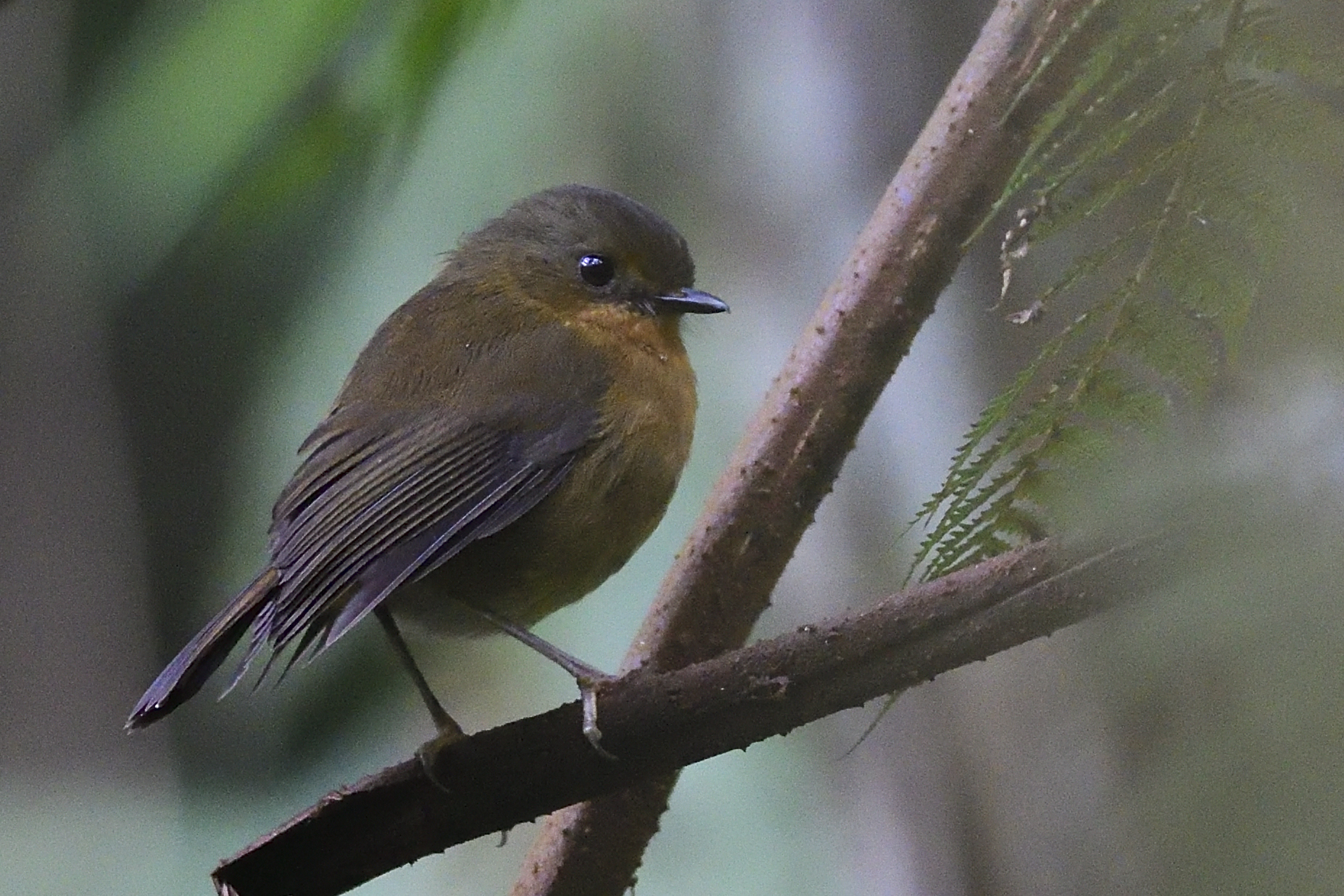
Rubeho Akalat, Sheppardia aurantiithorax – Endemic to the Rubeho Mountains, Tanzania
Day 17, Thursday, August 8 Mikumi to Iringa River Camp, Iringa
We packed camp early and headed for the Miombo Woodland just north of Mikumi. Timo, did not feel well this morning, but he tagged a long. He actually got worse and worse. However, we started birding and started running into quite a few of the Miombo specials: Miombo Blue-eared Starling, Meyer´s Parrot, Tiny Cisticola, Stierling´s Wren-Warbler, Grey Penduline Tit, Pale-billed Hornbill, White-crested Helmethrike, Speckled-throated Woodpecker, Green Malkoha, Little Sparrowhawk, Scaly-throated Honeyguide, Lizard Buzzard, Pale Batis, Green-capped Eromomela and Cinnamon-breasted Tit. At this time Timo had been several time to the bush toilet and could hardly stand on his feet. We still had one bird to go and at the spot, Elia heard a faint call in the distance. He went bush bashing and managed to get the bird a little closer. Even Tim managed to go a few 100 meters into the bush and there it was Livingstone Flycatcher. Not a lifer for me, but first time in East Africa. It even posed for a few seconds. Now birding had to be birding, because I was seriously worried about Timo´s health. We rushed back to Mikumi where he was promptly admitted to the local hospital and put on a drip. Nothing we could do, so we went and had breakfast. After a couple of hours, we went back to check on Timo, he was awake and had gotten his diagnosis: Typhoid! Apparantly he had washed a Mango in contaminated water up in the Ukaguru Mountains. I had not eaten that Mango, but both Martin and Elia had. To be on the safe side we all went on an antibiotic cure since the decease is very contagious. I offered to spend an extra night in Mikumi, but Timo refused so we pushed on towards Iringa. We had to make a few stops for Timo to rest, but eventually we got close to Iringa River Valley Camp where we dropped Elia at his home. We pushed on a few more km and reached the camp. Timo and Martin went out to get a target for Timo, the Purple-crested Turaco. We met a nice Doctor couple from Germany that gave Timo some medicine. We ate at the restaurant that night and was entertained by both Spotted Eagle-Owl and African Wood-Owl.
Some pictures from Day 17:

Arnott´s Chat family, Pentholaea arnotti

Pale-billed Hornbill, Tockus pallidostris

Little Sparrowhawk (Juvenile), Accipiter minullus
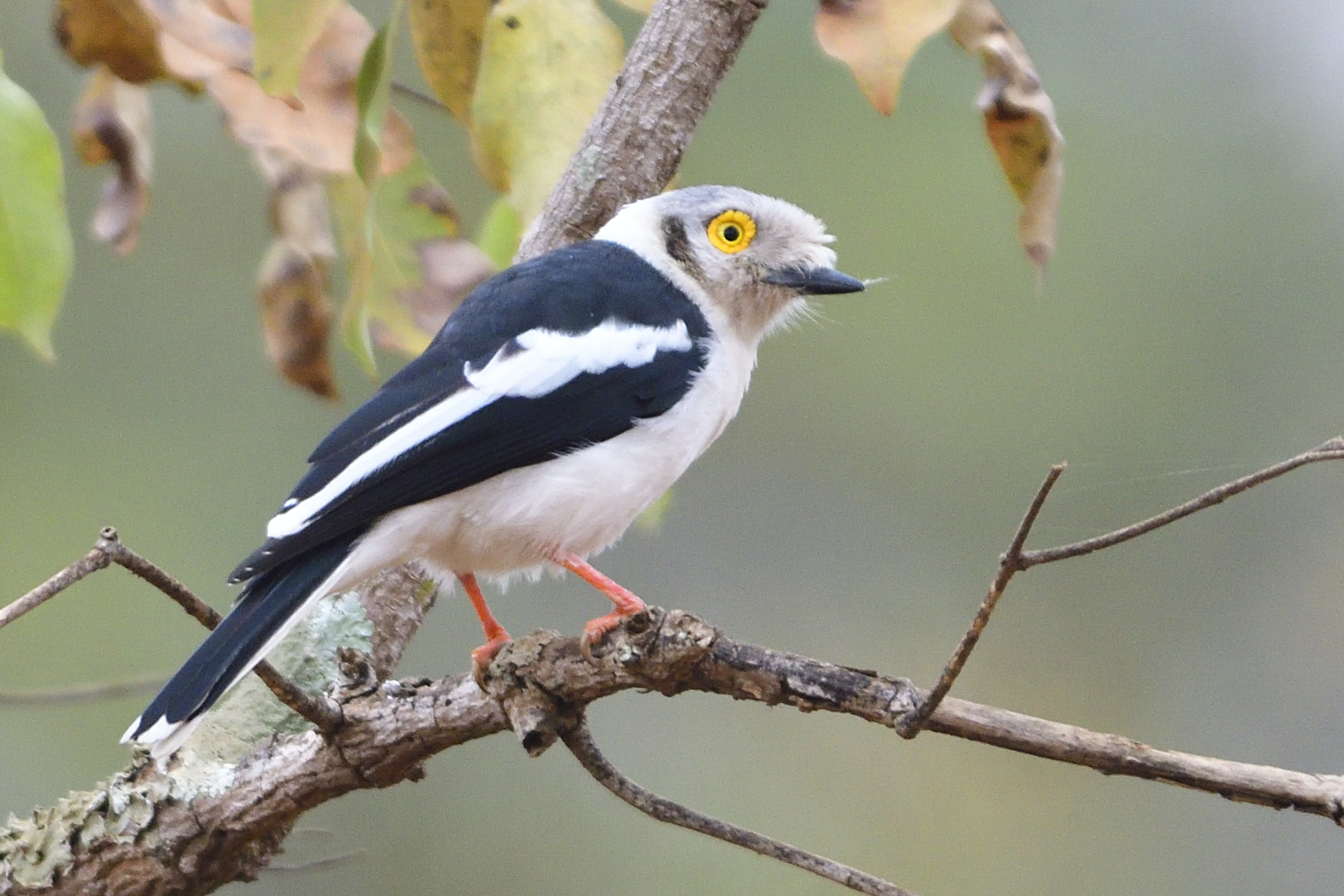
White-crested Helmetshrike, Prionops plumatus

Livingstone Flycatcher, Erythrocercus livingstoni – Endemic to SE Africa
Day 18, Friday, August 9 – Iringa to Uzungwa Scarp Forest
Elia joined us at the camp in the morning and we soon set out. I knew it would be a tough ride, but more than 90 km on a very bad road was quite hard. At one point we lost half the exhaust pipe. We pushed on and eventually we reached the small village before the forest. Here we recruited porters for our 3 nights stay in the forest. To my surprise, the locals had made a road all the way to the forest edge. We drove up, parked the car on the inside of the gate and were soon on our way up the steep forest track. It turned out to be only a little over an hour rapid walk to the well established camp. We wasted no time setting up camp and were soon out birding. Pale-breasted Illadopsis, Cinnamon Bracken warbler, Spot-Throat White-tailed Crested Flycatcher, Kenrick´s Starling, Mountain Buzzard, Dark Batis, Shelley´s Greenbul, Swynnerton´s Robin, Abyssinian Thrush, Orange Ground Thrush, Stripe-faced Greenbul, Livingstone´s Turaco, Moustached Tinkerbird, Dapple-Throat, Waller´s Starling and African Wood-Owl were some of the species recorded, but most of them only heard. We know knew that this was going to be extreme hard birding. We were back in camp and I had a wash in a nearby cold stream.

Timo and I are ready for Uzungwa Scarp Forest – Gaffa tape, Landy owners best friend, see the exhaust pipe 🙂
Day 19, Saturday, August 10 Uzungwa Scarp Forest
We woke up early, some people was out before the crack of dawn. I waited for the light. Around 08:00 it was light enough for me to go out. Eastern Brnonze-naped Pigeon, Forest Double-collared Sunbird, Evergreen Forest Warbler, Green Barbet, Placid Greenbul, Black-headed Apalis, Chapin´s Apalis and Scaly-throated Honeyguide were recorded (most of them not seen) before breakfast. After breakfast we went for a long walk. Again heard a lot of species including White-winged Apalis, again no see. It turned out to be a very frustrating place to bird. In the end we came to a little glade and there soaring high above us in the sky was A Cassin´s Hawk-Eagle. On the way back for lunch, Martin almost stepped on a Swynnerton´s Robin, but none of us others as much as saw a feather of it. After lunch, we heard the Dapple-Throat again and all 4 of us sat down to wait it out. I saw it briefly on a branch inside a bush and focused my camera there and after quite some time, it popped back at the same spot and I managed to fire of 10 frames. Terrible light and everything, but I got a picture of a Dapple-Throat in the Wild! None of the other 3 even saw the bird! We had glimpses off Iringa Akalat (4th Akalat for Timo on the trip) and Sharpe´s Akalat. I went to bed that night very frustrated over the incredible tough forest birding, but on the other hand very happy for the record shot of a Dapple-Throat.
Pictures from Day 19:

Cassin´s Hawk-Eagle, Aquila africana

Dapple-Throat, Modulatrix orostruthus – Endemic to Eastern Arc Mountains

Getting ready for the Dapple-Throat
Day 20, Sunday, August 11 – Uzungwa Scarp Forest
Our last full day in the forest, same frustration again, heard all the birds, but saw very few. Martin managed to find a Rufous-winged Sunbird. We had fleeting glimpses and I managed to get a record shot. Later I managed to get a shot of a Shelley´s Greenbul. The place must be a heaven for a bird recorder, but absolutely the most frustrating place me as a bird photographer has ever been.
Some pictures from Day 20:

Rufous-winged Sunbird, Cinnyris rufipennis – Endemic to Udzungwa Mountains, Tanzania

Shelley´s Greenbul, Arizelocichla masukuensis – Endemic to Eastern Arc Mountains of Tanzania and N Malawi
Day 21, Monday, August 12, 2019 Uzungwa Scarp Forest to Iringa River Valley Camp.
Last morning birding produced a fleeing glimpse of a Olive-flanked Robin-Chat before we packed camp and headed towards the car. Elia had a few spots for White-winged Apalis on the way down. We could hear them in the canopy, but again, no see. We reached the car and stopped a few places on the way out. We picked up 3 new lifers for Timo: Brown-headed Apalis, Churring and Black-lored Cisticola. The road back to Iringa was a nightmare as it was on the way in. We stopped briefly for a patch were we found Forest Double-collared Sunbird and then continued. We needed to go to Iringa town to stock up. At the top of the hill, I discovered that we had a flat tire. Evidently caused from the rough road. It took us some time to get this fixed so we reached the River Camp just as the light started fading. We quickly put up camp had food and retired. I will go back to Uzungwa Scarp Forest, but now at least I know what to expect.
Picture from day 21

Brown-headed Apalis, Apalis alticola
Day 22, Tuesday, August 13, 2019 – River Valley Camp – Udzungwa Forest Partridge site.
We started our journy to the new site. Before the Kitongo pass, we made a right turn and drove on bad roads for a long while. In the end we came to the rangers headquarters. The boys had organised food for us there. We had a nice chicken lunch before we continued in to the park. Our porters were waiting for us at the ranger station. I knew this was going to be a pretty tough hike. We set out walking a nice path over sort of undulating hills, but there was always a gully to get down to before you had to climb the other side. We soon split up so each could follow his own phase. In the end we came to a campsite at the edge of the forest after about a 2 hour walk. Now the real hardship was beginning. The path up the forest was more or less vertical and some places I felt like crawling on my hands and knees. After a while, I developed a technique where I did 100 steps and then took 20 deep breaths where I again took 100 steps. After what seemed like an eternity I finally reached the crest. From there it was downhill and easy going to the camp. It took me exactly 4 1/2 hour to reach the camp. I was saw exhausted that I just sat down in my chair and sat there until it was time to sleep.

Udzungwa Mountains from the Iringa site
Day 23, Wednesday, August 14, 2019 – Udzungwa Forest Partridge Site
When I woke up this morning I could not feel my legs. The others were eager to go. I asked Elia how far to the real site, he said about one hour and a half. I followed them for about 1 km, but was struggling and decided to go back to camp and let them go on. I relaxed and birded around camp for a while. I had a Olive-flanked Robin-Chat come close to me, but no pictures. After quite a few hours, the troop triumphantly returned to camp. They had heard a group of the Forest Partridge, stalked them for a couple of hours and finally had flushed them across the path, no pictures though. We had lunch and relaxed in camp. There was like a small amphi theatre close to camp and in the afternoon, we positioned us there. We were entertained by many Rwenzori (Usambara) Nightjars and an African Grass Owl did many fly byes right over our head. It was now pitch dark, so to get a picture of the Owl proved quite hard. In the end I somehow managed to get a picture. We retired to camp, had dinner and then sleep
Some pictures from Day 23

Strategically positioned for the afternoon action.

African Grass Owl, Tyto Capensis
Day 24, Thursday, August 15, 2019 – Udzungwa Forest Partridge Site
My legs felt a lot better this day so I went out with the boys. It was a long but not very strenuous walk. Very few birds to be heard or seen. We past the spot where they made contact with the Partridge the day before. After a few more km, Elia picked up the faint call of the birds. We bush bashed down to a small stream and sat down waiting for them to appear. We could hear them close by and they seemed to be coming closer. We were entertained by both Iringa and Sharpe´s Akalat while waiting. After about a 2 1/2 hour stalk out, Tim and I decided to bush bash towards them. The bushes were so thick so we made quite a bit of noice and we only managed to push the Partridges further away. We started our return and picked up Yellow-browed Seed-eater, Dark Batis and Moreau´s Sunbird (record shot) on the way back to camp. We relaxed at the camp and again went to ur Amphi theatre for the afternoon, but today, no Grass Owl showed up. Back to camp, made food and then sleep.
Some pictures from Day 24

Dark Batis, Batis crypta, Endemic to Eastern Arc Mountains.

Moreaus´s Sunbird, Cinnyris moreaui, Endemic to Eastern Arc Mountains, Tanzania
Day 25, Friday, August 16, 2019 – Udzungwa Forest Partridge Site via Mukumi to Honde Honde Camp
We packed camp in the morning and started the long walk back to the car. My legs felt very strong and I set out on my own phase. It was about an hour quicker to go back than up, but I was still happy when I got to the car. After a while, the other joined me and we packed up and left. Once back at the main road, we said our farewells to Elia. The three of us continued towards Mikumi. A long hard drive and the last 20 or so km to Honde Honde camp was absolutely dreadful. We arrived in camp. I had a long proper shower and decided to dine in the restaurant that night. I had been living on bush cooking for almost 2 weeks now, so decided I could afford the luxury. Timo and Martin opted to go to a local restaurant. I enjoyed my meal washed down with couple of cold Kilimanjaro beers.

Nice meal at Honde Hone Camp in the Udzungwas
Day 26, Saturday, August 17 – Honde Honde Camp – Ifakuru- Honde Honde camp.
Our plan was to go to Ifakara today in order for Timo to get the two Cisticolas and the Weaver + a few other birds on his list. We drove for an hour or so when I realized something was wrong with the car. One of the rods were coming out of my left rear axel. I realized it was too risky to continue, so I stopped at the nearest village and got hold of a local Fundi (mechanic). He could fix it, but did not have the spare part needed. It was bound to happen after all the bad roads my poor Landy had to endure during this trip. I told Tim and Martin to go on and they fetched local transport to go to Ifakara. I told them I would come after them as soon as the car was fixed. They left and the Fundi sent someone to Ifakara for a spare. Unfortunately, there were no spares in Ifakara. He then had to send someone all the way to Morogoro for the spare. I realised, the car would not be fixed that day. I sat down at a local bar with my feet on the table and relaxed the rest of the day waiting for the boys to come back from Ifakara. They arrived late afternoon. For some reason they let their transport go. No more dalla dallas (mini buses) going towards Honde Honde that night, so we ended up going back on 3 piky piky´s (Motorcycles). A terrible ride for an old man. Once in camp, I had dinner and retired early.
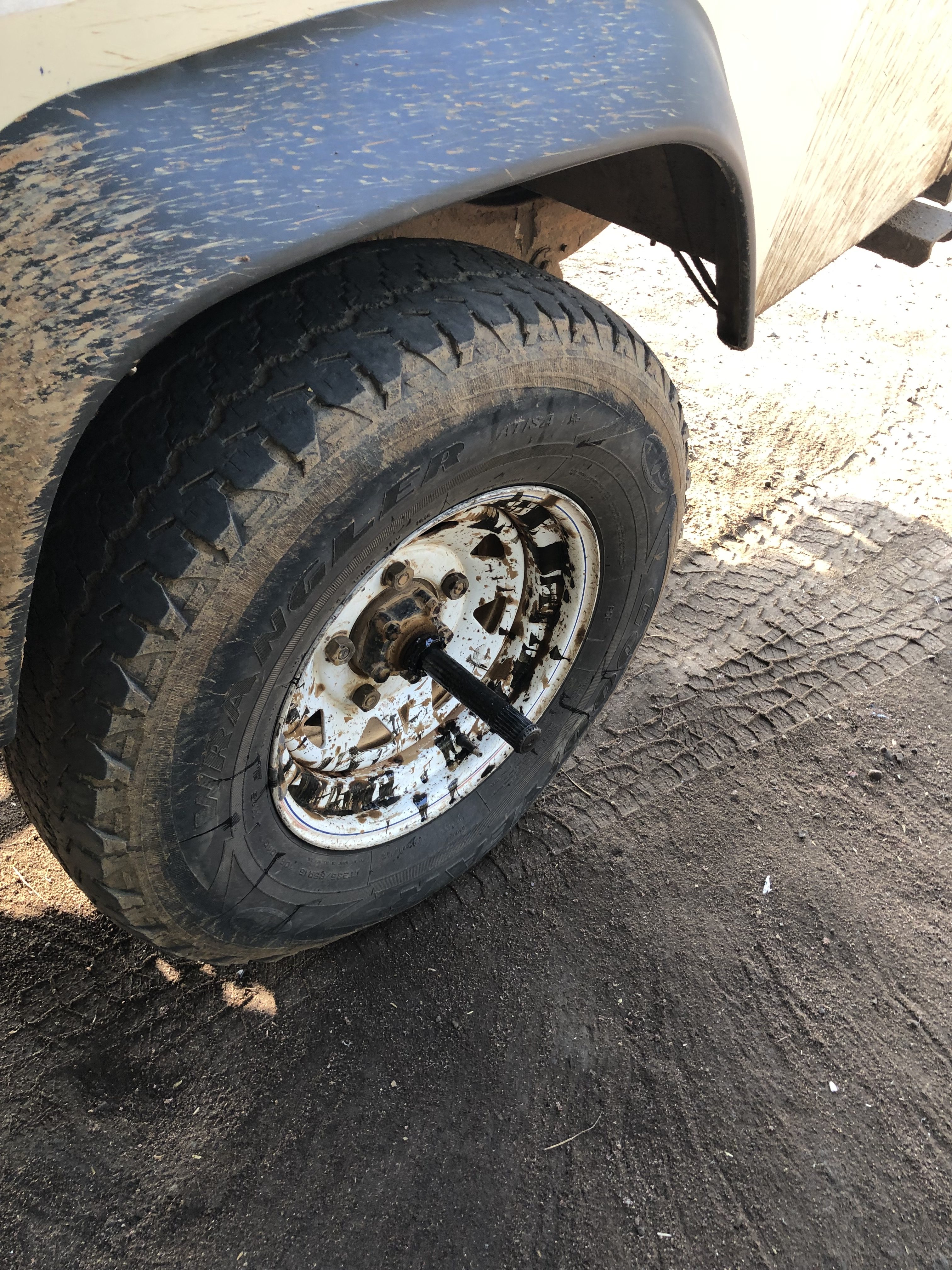
Did not want to continue with this sticking out?
Day 27, Sunday, August 18 – Honde Honde Camp
Tim had arranged with a ranger to do a walk in Udzungwa National Park looking for some primates this day, so Martin and I got on our Piky piky´s and headed back to where the car where parked. We had placed an Askari (guard) to watch over the car, but we were still happy to see that the car was still in one piece. We spoke with the Fundi and he said they had located the part in Morogoro and it was on its way. Martin and I had breakfast at a very local restaurant and went to yesterdays bar to wait for the part. After quite a few hours, the part arrived and in no time, the car was roadworthy again. We drove back towards Honde Honde and came just in time to pick up Timo from his hike at the gate of the Udzungwa national park. We took one extra night at Honde Honde.
Day 28, Monday, August 19 Honde Honde Camp – Same
My last day with Timo. He had a flight back home later this evening. We started on our long way back. Fortunately for me, he agreed to take a bus from Chalinze. We dropped him there. Martin and I continued. I dropped Martin at Segera and arrived very tired at the Elephant Motel in Same where I stayed the night. The day after it was an easy ride back to Kiligolf.
This was an interesting trip. The first part was a standard trip for me. On the second part we visited quite a few places I had never been to. I have been to the Southern highlands of Tanzania many times, but never to some of the spots we visited this time. The birding was extremely challenging + some personal problems underways did not help. However; I now know the challenges of these birding spots and can warn future guests about the hardships. Stay tuned for my next trip report: Sybrand von Niekerk from South Africa did an African big year in 2019. We did 2 weeks in Tanzania and 2 weeks in Kenya and we added 234 birds to his African list.